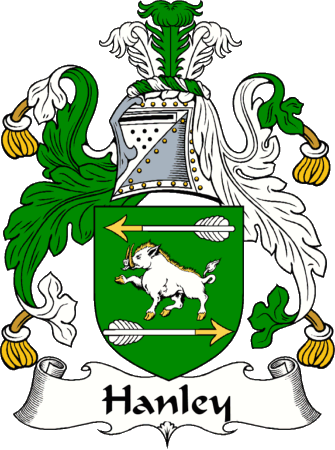
English Origin
When the ancestors of the Hanley family emigrated to England following the Norman Conquest in 1066 they brought their family name with them. They lived in Hawley, Somerset. The most probable derivation of this name suggests that it comes from the Old Norman word haugr, which means mound, and the Old English leah, which means clearing. Another derivation supported by some examples suggests that the name indicates tat the name is an Anglicized version of the place-name La Haule-De-Bec in Greteuil, Normandy.
Irish Origin
The Irish surname Hanley, also found in England, is an anglicized form of the Gaelic name Ó hÁinle meaning “descendant of Áinle,” a personal name meaning “champion.”This is the name of a ruling family in the western province of Connacht; it is now common in southern Ireland. When found in England the name Hanley is an habitational name from any of various places, such as Handley in Cheshire, Derbyshire. Northamptonshire, and Dorset and Hanley in Staffordshire and Worcestershire.

 Hanley Family History
Hanley Family History
The story behind the Hanley surname.
Hanley Dates, origins and meaning
This is a distinguished Irish surname. Deriving from the ancient Gaelic spelling of O'hAinle", it originates from the word "ainle", meaning beauty or grace. Traditionally, Irish family names are taken from the heads of tribes, revered elders, or some illustrious warrior, and are usually prefixed by O', meaning grandson or male descendant of, or Mac, denoting son of. They are often extremley 'robust', and unlike this surname, rarely physically complimentary. The O' Hanley's originated on the banks of the River Shannon in the county of Roscommon, where the place Doohyhanly is named after them. The sept was a branch of the royal house of O'Conor, of which Rory O'Conor was the last High King of Ireland (1166 - 1175).
The Hanley coat of arms is a green shield with a silver boar passant, between two silver arrows barways. The first recorded spelling of the family name is shown to be that of Donal O'Hanley, and dated 1085, in the ancient ecclesiastical records of Dublin, 1022 - 1166.
 Hanley migration to Australia
Hanley migration to Australia
Emigration to Australia followed the First Fleets of convicts, tradespeople and early settlers.
Hanley Settlers in Australia in the 19th Century
- Mr.William Hanley, (b. 1781), aged 38, Irish gardener who was convicted in Dublin, Ireland for 7 years, transported aboard the "Bencoolen" on 24th April 1819, arriving in New South Wales, Australia before being transferred to Tasmania via the "Admiral Cockburn"
- Mr. Edward Hanley, (b. 1793), aged 35, Irish ploughman who was convicted in County Tipperary, Ireland for 7 years for stealing, transported aboard the "Borodino" on 11th February 1828, arriving in New South Wales, Australia
- Mr. James Hanley, (b. 1798), aged 30, Irish ploughman who was convicted in County Tipperary, Ireland for life for stealing, transported aboard the "Borodino" on 11th February 1828, arriving in New South Wales, Australia
- Mr. John Hanley, (Hanly), Irish convict who was convicted in Limerick, Ireland for 7 years, transported aboard the "Borodino" on 11th February 1828, arriving in New South Wales, Australia
- Charles Hanley, who arrived in Adelaide, Australia aboard the ship "Anna" in 1851